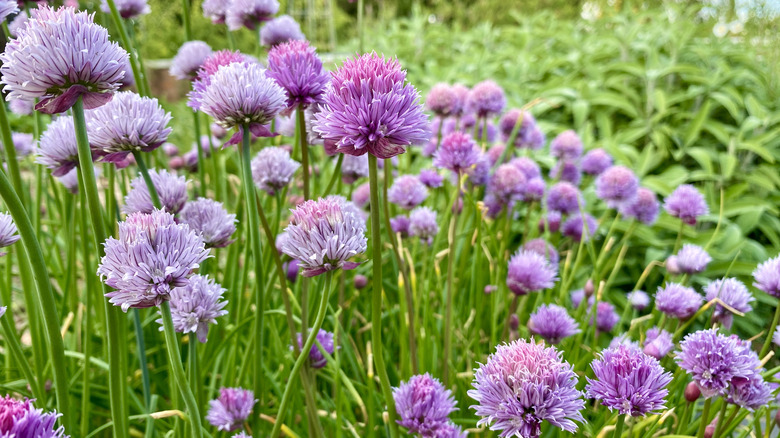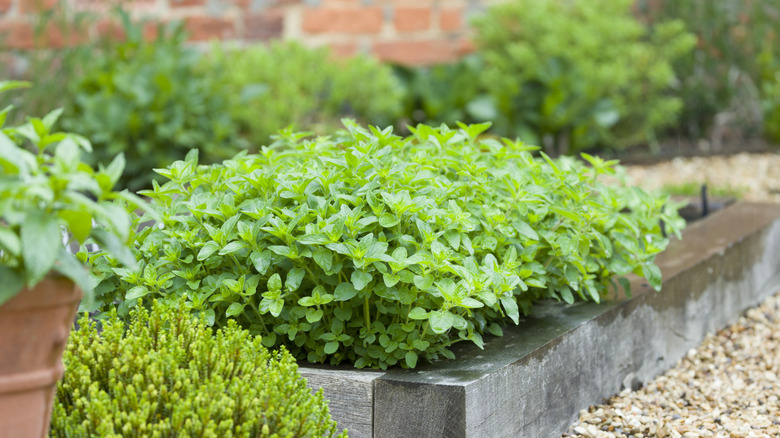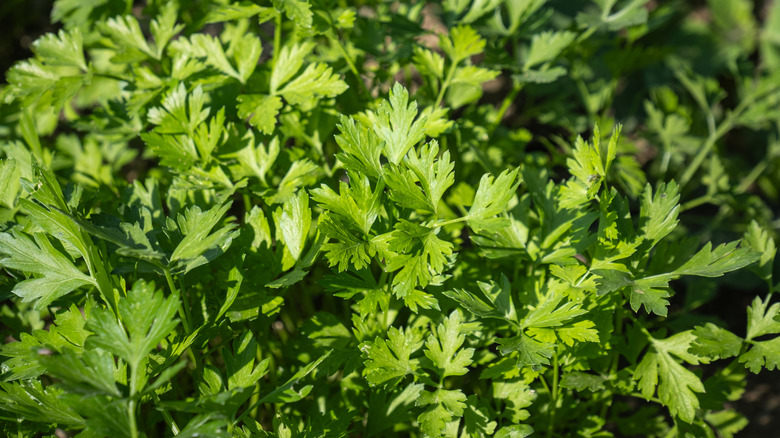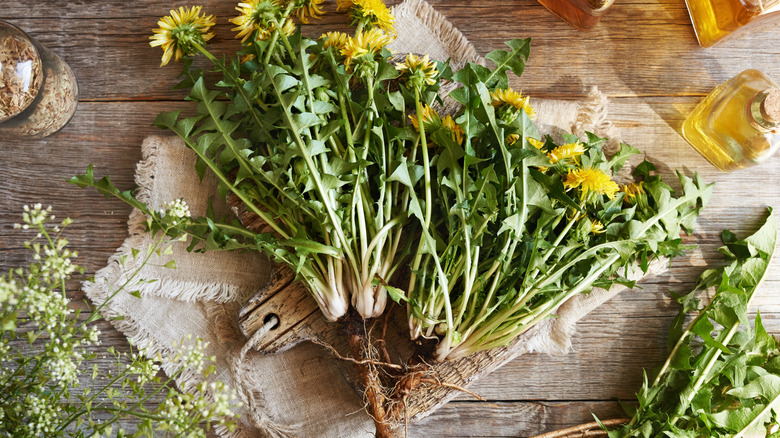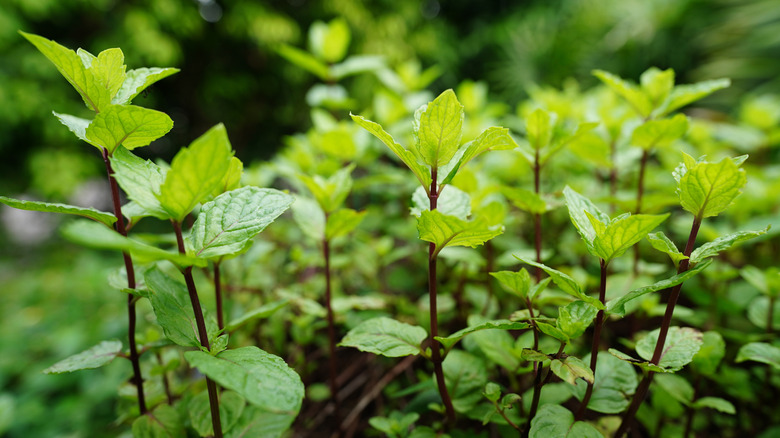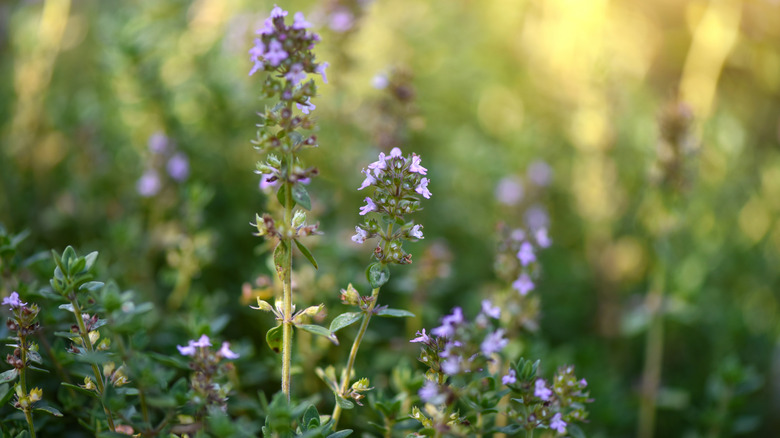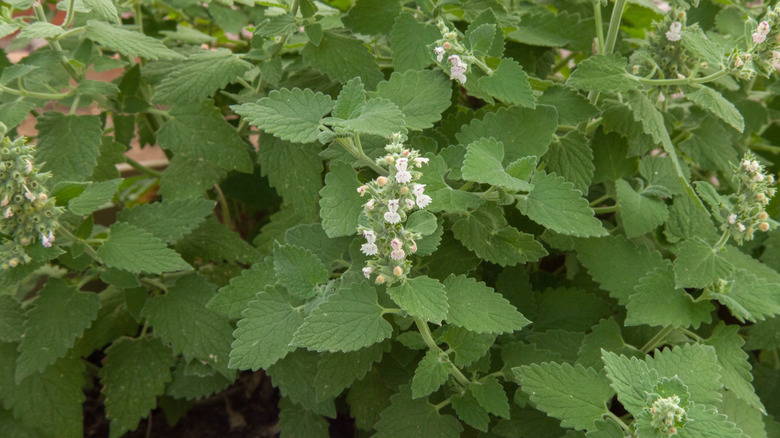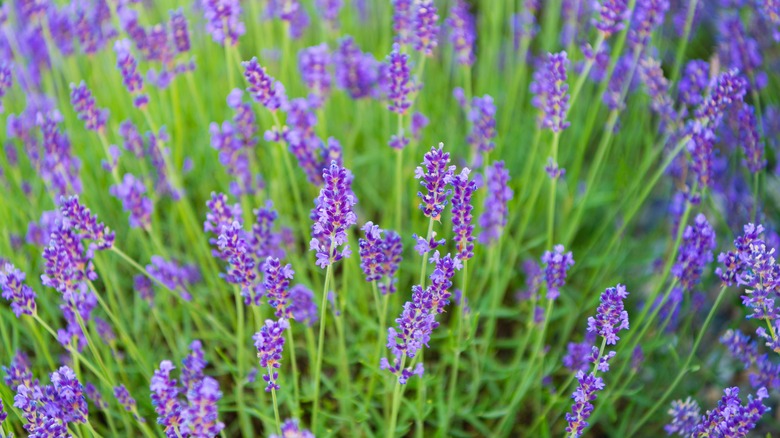14 Herbs To Cut From The Garden And Dry Before The Winter Freeze Hits
We may receive a commission on purchases made from links.
Even though late summer and fall can be some of the busiest weeks of the growing season, many gardeners would agree that the extra time it takes to gather crops in the fall is well worth the effort. Still, it can be hectic, as there's a race against time, with the weather acting as an unpredictable referee and everything ripening at once in a hasty sprint across the finish line. As you tidy the garden and tie up any loose ends before the winter freeze hits, cut some herbs from the garden and bring them into your pantry while you still have a chance. It's the best way to continue enjoying the flavors of summer long after the harvest season has passed.
Herb preservation can get overlooked in the hubbub of the harvest, but several plants can be harvested before winter in a last-ditch effort to savor the flavors of summer. Tender annuals like basil and dill are ripe for harvesting right up until the first frost, and many cold-hardy herbs can continue to be cut and preserved even after a hard freeze.
The best time to harvest herbs varies depending on the plant, your intended use, and your growing season. Whether you grow a thriving herb garden or just a few container plants, it can be hard to let go of the fresh herbs you enjoyed in your meals throughout the growing season, and it's only natural to want to take some of that with you into winter.
Sweet basil
Sweet basil (Ocimum basilicum) is a warm-season herb grown as a tender annual in USDA Hardiness Zones 2 to 11. Growth slows in cool temperatures, and the first frost usually wipes out basil, so it should be cut to the ground at the end of the season. It's hard to compare the flavor of fresh basil with either dried or frozen, but many people prefer the flavor of frozen basil. However, drying is the easiest method; just be sure to leave the leaves whole to preserve as much flavor as possible.
Chives
Like many herbs, chives (Allium schoenoprasum) are better when they are harvested throughout the summer in zones 4 to 8, but you can cut them back to the ground in the fall and harvest them. Cut the leaves into small slices before drying or freezing chives. Any time you're freezing herbs, avoid moisture and odor transfer by wrapping them in plastic and aluminum foil before placing them in the freezer. Also, remember that dried herbs are three to four times as potent as fresh herbs.
Oregano
Oregano (Origanum vulgare) is another one of the herbs you can harvest throughout the growing season, being careful not to take too much from each plant so that it continues to thrive. Once fall comes, you can prep your oregano plants for winter in zones 4 to 8 by cutting them back and drying whatever is usable. Herbs can be hung in bundles or laid flat on sheets or screens. However, air-drying herbs requires low humidity, so you may have to use another method, such as a dehydrator, oven, air fryer oven, or microwave.
Dill
Dill (Anethum graveolens) is one of the most popular culinary herbs, and when dried, it is an excellent addition to sauces and condiments. This half-hardy annual herb prefers cooler weather, so succession plantings of dill can provide a harvest later in the season in zones 2 to 11. You can even extend the harvest further with row covers since dill can tolerate temperatures down to 25 degrees Fahrenheit. Harvest before it gets too cold and get dill into a dehydrator, preferably one with silicone sheets that catch the tiny flakes from dill's feathery leaves.
Echinacea
If you enjoy using products like Yogi Echinacea Immune Support Tea to support your health during the winter flu season, gathering the root from the purple coneflowers (Echinacea purpurea, Echinacea angustifolia, and Echinacea pallida) in your flower bed will save you money. Wild echinacea populations are overharvested, so using your own is an eco-friendly way to enjoy a sustainable supply. If you're already dividing your plants in the fall, this is a perfect opportunity to take whatever you don't need to plant. For harvesting, wash it thoroughly, then pat it dry before cutting it into thin strips.
Parsley
Many herbs used in the kitchen come from different parts of the plant, not just the leaves. Take parsley (Petroselinum crispum), for example. You can use all parts of the parsley plant fresh or dried, including the stems and root, as was popular in medieval times. While parsley is a biennial, it's often grown as an annual in zones 2 to 11. Whether you choose the flat leaf or curly leaf parsley, as long as they are green, you can continue to harvest parsley leaves for drying.
Dandelion
While some people consider this plant an invasive weed, others are busy putting it on their tea shelf. Dandelion root (Taraxacum officinale), hardy in zones 2 to 11, makes an excellent tea when it is roasted. Although late fall isn't the best time for harvesting some types of herbs, it's an ideal time for harvesting herbs with edible roots like dandelion, chicory, and horseradish. As long as you haven't used harsh chemicals in an effort to stop dandelions from taking over your yard, they have antioxidant properties that promote health in numerous ways.
Mint
Flowering herbs can be slightly bitter, so it's usually best to harvest mint (Mentha spicata) before it starts blooming. This can occur anytime during the summer or fall in zones 4 to 9. As anyone who has ever grown mint will tell you, this vigorous plant can be difficult to keep in check, so over-harvesting is rarely a concern. In fact, if you cut mint back when it starts to flower, it will encourage new growth, which can be harvested as long as it's green. If you enjoy fresh mint, dig it up in the fall to plant indoors.
Thyme
Thyme (Thymus vulgaris), hardy in zones 5 to 9, is another herb that you can harvest all winter long, depending on your growing season. Once the temperatures drop in the fall, however, plant growth slows down, and you need to avoid over-harvesting. To harvest thyme, cut sprigs from the edges of the plant so that the woody parts in the center continue to support new growth. Like many Mediterranean herbs, the best time to harvest thyme is right before it blooms.
Catnip
It wouldn't be fair to cats if we didn't include catnip (Nepeta cataria) in the list of herbs to harvest before winter hits. Whether you're growing catnip for the cats or to attract pollinators to your zone 3 to 9 garden, be aware that this plant can spread and become a nuisance. It's often a good idea to cut it back a couple of times each year just to control its growth. Drying some at the end of the season ensures you have a plentiful supply for use in cat toys and herbal tea blends.
Lemon verbena
Lemon verbena (Aloysia citriodora) is hardy in zones 8 to 10, so it won't survive the winter in many regions if left outdoors. Whether you choose to bring it indoors when cold weather comes or cut it back completely and harvest the leaves, lemon verbena is used to add lemony flavor to sauces and recipes, including as a substitute for the zest of lemon. Easy to dry, lemon verbena can either be hung in bundles, air-dried on trays, or processed in a food dehydrator.
Lavender
While there are hundreds of herbs cultivated and preserved through drying, one of the most versatile is lavender (Lavandula). It is used for culinary, aromatic, and medicinal purposes. There are several cultivars available, with the most culinary type being English lavender (Lavandula angustifolia), which is hardy in zones 5 to 9. Whether you're preserving lavender for sachets, tinctures, or cordials, English lavender is easy to air-dry by hanging in bundles. If the humidity is too high, you can also use a dehydrator or freeze-drier.
Sage
Garden sage (Salvia officinalis) should be harvested a couple of times during the summer, which is the peak growing season, by cutting it back six to eight inches. You can bring this herb into your pantry before the winter freeze hits and use it in your holiday stuffing, but just be careful not to cut back too much. When preparing your sage plants for winter in zones 4 to 8, save the heavy pruning for later. Garden sage should be hard pruned in the late winter or spring to encourage new growth.
Rosemary
Also from the Salvia family, rosemary (Salvia rosmarinus) is another popular herb that can be harvested right before winter. In fact, rosemary is evergreen and can be harvested throughout winter like thyme, sage, and lavender. Most evergreen herbs should be pruned in the spring and harvested in the summer, but you can harvest some rosemary in the fall without harming the plant. Various cultivars of rosemary can be grown in the ground or in a planter in a wide range of climates, from zones 5 to 11.


